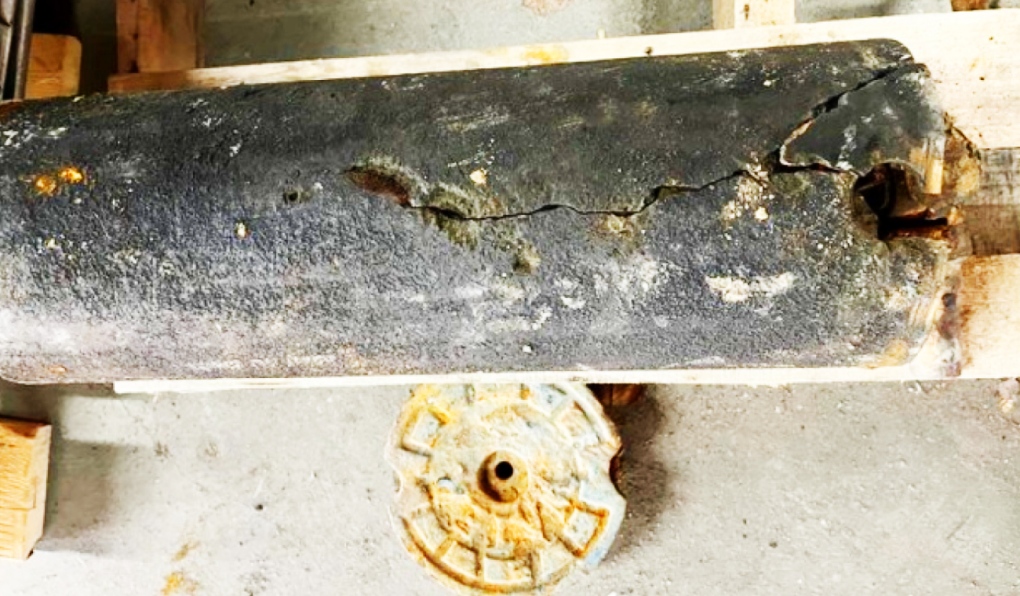Sudbury has old water pipes with leakage rates as high as 47%
 A pilot project in Sudbury using high-tech caps on water hydrants detected this crack in an underground cast iron pipe installed in 1945. (Supplied)
A pilot project in Sudbury using high-tech caps on water hydrants detected this crack in an underground cast iron pipe installed in 1945. (Supplied)
Greater Sudbury has the oldest system of underground water pipes among similar cities in Canada, according to a new report headed to a city committee next week.
While overall leakage rates are about average in Sudbury, in the Levack area it was 47 per cent, meaning almost half of the drinking water processed in the area was being lost.
More recently, a very large leak was uncovered in the Levack system that was largely responsible for the problem.
The report, headed to the operations committee Jan. 16, was delayed by the COVID-19 pandemic. It’s part of an overall strategy to reduce water loss in the pipes in the city, which are 56 years old on average and are subject to widespread cracking.
Working on the problem is a task force with a five-year mandate to come up with ways to reduce the amount of clean water lost to leaky pipes.
The task force’s goal is to find strategies to get the rate down to an average of 15 per cent. Other areas of Greater Sudbury with high water loss rates include 28 per cent in parts of the old City of Sudbury, 22 per cent in Falconbridge and 20 per cent in the Naughton area.
“There are many reasons why a water distribution system may experience leaks,” the report said.
“Leaks may be a result of aging infrastructure, corrosion, water hammer/pressure surges, frost, ground and soil movement, poor design or inspection, inadequate construction practices, defective or improper valves, fittings, or joints, vibration from road traffic or road rehabilitation, or earthquakes.”
The key to combating leaks is to find them, the report said, and technology is making it easier. One of the main ways is using acoustic devices so an operator can either hear the water leaking, or see it using a signal meter.
Other technology is built into water metres that measures how much water passes through the system compared to how much is pumped from water stations.
“The difference is an indicator of the total losses in the system including leakage in real time,” the report said.
In addition to providing information to the city, the high-tech water meters can also tell customers real-time information about their water usage. For example if there’s a sudden spike in water consumption, customers could it see it immediately.
“Residents who have had their (water meter) upgrade completed will have access to this modern web portal where they can find detailed information about their household water use, track and compare their water usage over time, as well as be alerted to possible leaks via a continuous flow notification,” the report said. See the full report here.
CTVNews.ca Top Stories

Can the Governor General do what Pierre Poilievre is asking? This expert says no
A historically difficult week for Prime Minister Justin Trudeau and his Liberal government ended with a renewed push from Conservative Leader Pierre Poilievre to topple this government – this time in the form a letter to the Governor General.
'I'm still thinking pinch me': lost puppy reunited with family after five years
After almost five years of searching and never giving up hope, the Tuffin family received the best Christmas gift they could have hoped for: being reunited with their long-lost puppy.
Wrongfully convicted N.B. man has mixed feelings since exoneration
Robert Mailman, 76, was exonerated on Jan. 4 of a 1983 murder for which he and his friend Walter Gillespie served lengthy prison terms.
'Sonic 3' bests 'Mufasa: The Lion King' at the box office
In the holiday season battle of big-budget family movies, Paramount Pictures’ “Sonic the Hedgehog 3” sped past the Walt Disney Co.’s “Mufasa: The Lion King” to take the top spot at the box office ahead of the lucrative Christmas corridor in theaters.
Pickup truck driver killed by police after driving through Texas mall and injuring 5
A pickup truck driver fleeing police careened through the doors of a JCPenney store in Texas and continued through a busy mall, injuring five people before he was fatally shot by officers, authorities said.
6 adults, 4 children taken to hospital following suspected carbon monoxide exposure in Vanier
The Ottawa Police Service says ten people were taken to hospital, with one of them in life-threatening condition, after being exposed to suspected carbon monoxide in the neighbourhood of Vanier on Sunday morning.
Two U.S. Navy pilots shot down over Red Sea in apparent 'friendly fire' incident, U.S. military says
Two U.S. Navy pilots were shot down Sunday over the Red Sea in an apparent 'friendly fire' incident, the U.S military said, marking the most serious incident to threaten troops in over a year of America targeting Yemen's Houthi rebels.
Big splash: Halifax mermaid waves goodbye after 16 years
Halifax's Raina the Mermaid is closing her business after 16 years in the Maritimes.
Second body recovered from site of B.C. landslide
The second resident of a home that was destroyed by a landslide in Lions Bay, B.C., last weekend was found dead Saturday, officials confirmed.
































